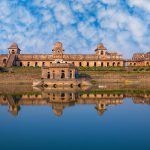I live in a city called Gwalior which is a 3hrs drive from Agra – home to the world-famous Taj Mahal. Gwalior makes for a perfect stop if one is travelling from Agra to Khajuraho. It is a historic city which is best known for its imposing hilltop fort and I happen to be fortunate enough to be living inside the fort. There are many sights to visit such as the fort palace, temples including a Sikh temple which has a very important history of its own, museums and religious water bodies. Every evening there is an interesting light and sound show as well. The fort can also be explored on bi-cycles which are available right at the entrance.

I’m happy to have gotten this chance to showcase some of the lesser-known sights in and around Gwalior. The stunning temples of Mitawali, Padavali and Bateshwar which are in close proximity to each other is a mere 40 kms from Gwalior.
Mitawali is situated on top of a hill and there are about 100 steps to reach this splendidly round temple built in the 14th century. Many visitors have drawn conclusions that this temple might have been the inspiration behind the Parliament House in Delhi. One look at the temple and it sure is easy to believe that. However, no book on the Parliament of India ever mentions this temple. Inside there are sixty-four small temples. At the centre of the enclosure stands a large circular pavilion with two concentric rings of pillars. This shrine is dedicated to Shiva and is well maintained.

Padavali is a fortress built around a temple dedicated to Shiva. While the temple is believed to built during 8th to 10th century, the fortress was built around it much later in the 18th century. The entrance is guarded by a pair of lion and lioness. Inside the temple, every inch of stone is densely carved with scenes from Hindu epics and religious scripts. The Hindu trinity of Brahma, Vishnu and Shiva are depicted here in their childhood, youth and old age. One can also see erotic carvings at Padavali because of which it is also known as the mini Khajuraho.
Bateshwar is a cluster of 200 mini temples dedicated to Shiva and Vishnu. Spread over 25 acres of land, these temples were constructed in 8th to 10th century. Some temples look pristine while others lie in ruins. The temples are built in a bowl-shaped valley surrounded by hills and the jungle nearby is full of beautiful birds such as peacocks, parakeets and kingfishers. Possibly an earthquake might have brought the whole complex down, so you see lot of breakage but no intentional vandalism or plunder. Starting in 2005, the Archaeological Survey of India started putting the pieces together and the site started taking shape. About 100 temples have been restored so far and the work continues. There are thousands of temple stones and pillars lying in the complex, all awaiting their turn to be transformed back into temples.

It is also said that Mitawali, Padavali and Bateshwar made a golden triangle in which a university existed about a 1000 years ago! The teaching centre was said to be a hub that imparted education in Mathematics, Astrology and Hinduism. If someone is driving from Agra to Gwalior these sights can easily be visited by taking just a little detour. If one takes a train from Agra to Gwalior then, a full day excursion can be planned, which will take 5-6 hrs.






Your gwalior content is wonderful, anny advice if I have to visit Yogini temple ,as Indian parliament dezine was influenced by .
Regards
Smiles